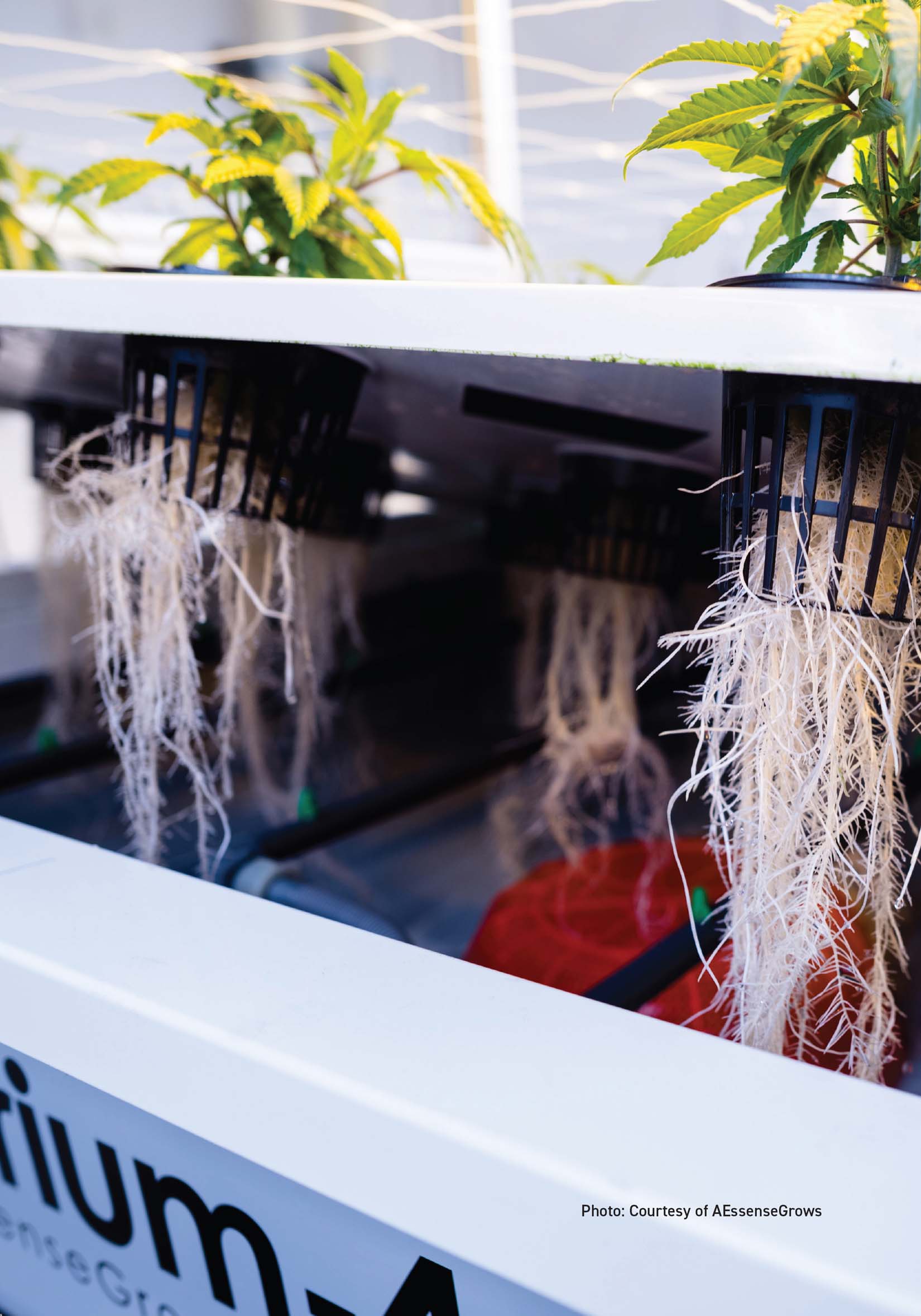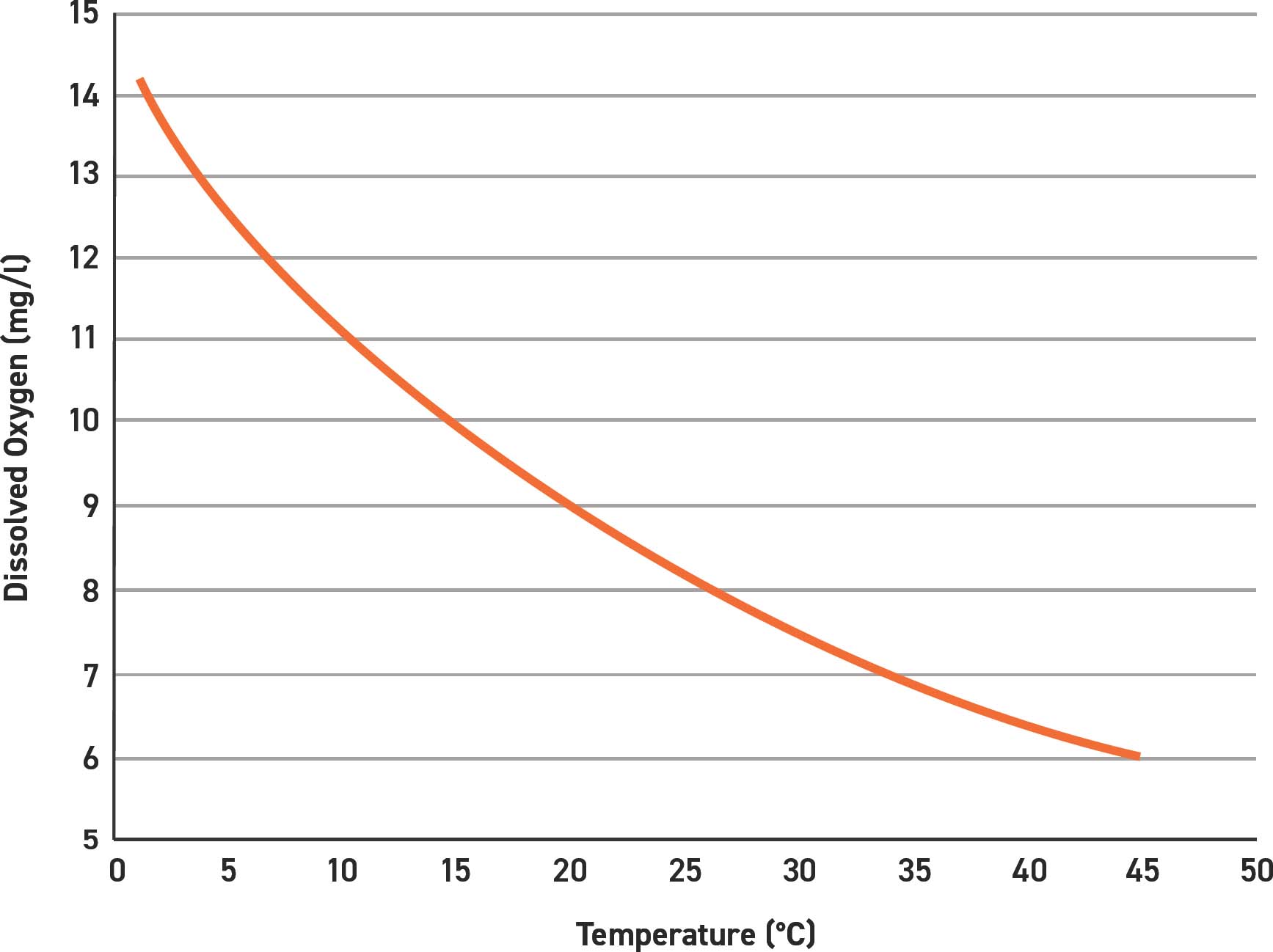
OXYGEN
All of the plant’s living tissues require oxygen for aerobic respiration, from the bottom of the roots to the tops of the shoots. If oxygen becomes a limiting factor for any of those plant parts, the plant’s rate of respiration will dip, and its ability to perform its normal activities will decrease. Theoretically, oxygen can be a limiting factor in the stems, leaves, and flowers; however, in practice, it is nearly impossible for that to happen. Oxygen stress is only a real possibility in the root zone, when oxygen uptake by the plant’s roots outpaces oxygen’s replacement there.
Oxygen Sources for Plants
Plants have three sources of oxygen:
- Oxygen released during photosynthesis but held in the plant structure
- Oxygen in the atmosphere
- Oxygen dissolved in water, which the roots absorb
Cannabis is terrestrial, meaning its roots explore the soil or whatever growing medium they are in. Underground roots do not see the light of day, and therefore do not have access to atmospheric oxygen.
Atmosphere
There is a lot of oxygen available in the atmosphere, which is about 21% oxygen. The roots’ source of oxygen is through diffusion to the root zone.
Oxygen diffuses 10,000 times slower through water than it does through air. Roots growing in compacted soil or degraded growing medium with little air porosity can lose access to oxygen very quickly. It is imperative that the growing medium or soil has enough air porosity that oxygen can diffuse through the small air spaces between the soil particles. If the plant’s roots are actively respiring, oxygen stress can occur within 20 to 30 minutes.
The primary way roots get oxygen is through diffusing through the air pores in the soil or growing medium or via water that is saturated with dissolved oxygen. When soil is watered from the top, the draining water creates a vacuum in its wake that pulls fresh air into the ground.
Dissolved in Water
Roots can also absorb oxygen that is dissolved in water or nutrient solution. As long as the water is saturated with oxygen, every time plants are irrigated or fertigated the roots get a fresh delivery. As temperatures rise, the rate of respiration in the roots increases.
Although oxygen in the atmosphere is at a concentration of about 21%, oxygen dissolves in water and maxes out at 8.3 ppm at 77°F (25°C). At 68°F (20°C), the dissolved oxygen concentration in water maxes out at 9.1 ppm.

The orange line represents maximum saturation levels of dissolved oxygen at different temperatures. As water temperatures increase, the capacity to store dissolved oxygen decreases.
As water temperatures decrease, the saturation level increases. The question arises: Does it make sense to decrease the root zone temperature to increase oxygen availability to the roots? Unfortunately, a decrease in root zone temperature also drastically decreases the rate of root respiration, lowering the roots’ metabolism and productivity. Even though more oxygen may be available in a cooler root zone, slower root respiration rates slow delivery of water and nutrients to the canopy. The ideal root zone and nutrient solution temperature should range between 68°F (20°C) and 72°F (22°C) in water culture and up to 75°F (24°C) in planting mix, where the water is interspersed with air. Planting media temperatures can run slightly warmer.
Dissolved oxygen (DO) is the primary source of oxygen for roots in aeroponic production. Growing in a physical growing medium requires frequent fertigations with oxygen-saturated nutrient solution.
Normal versus Low Oxygen Levels
Normoxic conditions mean that the level of oxygen is not a limiting factor for respiration in the root tissue. The roots are actively growing and absorbing nutrients and water sufficiently. Root respiration is heavily dependent on temperature and oxygen concentration. If the oxygen concentration declines with a constant root temperature, the rate of respiration will also slow down. As respiration rates drop, the amount of energy available to do work also decreases. This is the energy the roots need to grow, absorb nutrients, and maintain cellular integrity.
The root environment goes from normoxic to hypoxic when the concentration of oxygen in the root zone drops to a level so low that not enough energy is available from respiration for the roots to properly function. Hypoxic root conditions lead to several problems for the plant. The rate of nutrient absorption declines, and root growth decreases and dies. Plant roots signal to the leaves to close the stomata. Water absorption through the roots declines and then stops. This decreases the plant’s ability to photosynthesize, since the stomata are closed and no longer allow CO2 to enter the leaves. The combined effects of a hypoxic root zone range from a smaller yield to plant failure.
As oxygen concentrations continue to decrease in a hypoxic root environment, the root zone eventually becomes anoxic, that is, it has virtually no oxygen. Root respiration stops completely and usually results in root die-off. Not only does this decrease the surface area for nutrient and water absorption, but the dying roots provide entry points for microbial pathogens such as Phytophthora cinnamomi (Jacobs et al. 1997).
An oxygen-enriched environment makes a big difference in plant vigor; more so for unrooted cuttings than rooted plants, but both benefit from sufficient oxygen concentrations. Root initiation requires more oxygen than regular root maintenance, which is why unrooted cuttings see a bigger benefit. Root growth and overall root mass accumulation are improved when oxygen is not a limiting factor. Root growth and development is best with oxygen-saturated media, which is why it is so important to have high oxygen levels when taking cuttings for vegetative propagation. Root initiation from shoot tissue requires adequate oxygen levels.
Increasing Oxygen in the Root Zone
Passive approaches capitalize on how roots get their oxygen. Oxygen naturally diffuses through the air spaces of a porous growing medium for soil. Using a growing medium with particles large enough to leave space for air once the soil drains is essential for allowing the passive movement of oxygen-containing air through the root zone.
Proper management of the irrigation schedule is crucial in optimizing oxygen availability for the roots. Growing plants in fine-grain or compacted soil or a growing medium that has low porosity leaves little breathing room for the roots.
Cannabis suffers from a waterlogged soil because it is more likely to be hypoxic, since the pores in the soil are filled with water.
Irrigating with low-oxygen water without allowing the soil to dry out between watering is the worst scenario, since oxygen never gets the chance to diffuse through the pores of the growing medium. The water being introduced into the root zone is not bringing oxygen with it. Allowing for the growing medium to dry out a bit between irrigations promotes oxygen availability in fine-textured soils.
Irrigating with oxygen-saturated water is another way to passively introduce oxygen to the roots. Waterlogged soil is not harmful to the plants as long as the root zone has plenty of oxygen. Plants can be irrigated continuously as long as the nutrient solution is saturated with oxygen.
The theory behind growing in aquaponic production is the roots are constantly being showered with nutrient solution that is always exposed to air. The high exposure to oxygen allows for constantly saturated water raining down on the roots.
Increasing oxygen concentrations in water is not difficult to do. There is so much oxygen available in the atmosphere that actively bubbling air through water in a storage tank with an aquarium pump attached to an air stone is sufficient.
A pump-over or cascade can also be used to oxygenate water in a storage tank. A pump creates a spray or jet that splashes back into the water and mixes with the air. This increases the DO saturation. The larger the surface area of air-to-water interaction that occurs, the quicker the water becomes saturated with oxygen.
Increasing the dissolved oxygen (DO) concentration in fertigation solutions can be done through several methods.
The simplest is a venturi system. Air is drawn into a flowing liquid so that when a hole is drilled into the pipe and tubing is attached, the water is automatically aerated as it flows. The Mazzei Airjection Irrigation system makes it easy to introduce oxygen-laden air into the water-nutrient solution. Just hook it up to the irrigation line, and it draws air into flowing water automatically. It requires no power and has no moving parts.
Bubbling air through the stock solutions and water storage tanks is one of the best ways to introduce oxygen into the system, as it is inexpensive and easy to maintain. Some air pumps can increase the temperature of the nutrient solution, which should be monitored.
Other than air, there are other products available that increase dissolved oxygen concentrations that also sanitize the water. Ozone (O3) and hydrogen peroxide (H2O2) are strong oxidizing agents that neutralize microorganisms in the water. Both compounds naturally break down to produce oxygen:
Ozone breakdown
2O3 → 3O2
Hydrogen peroxide breakdown
2H2O2 → 2H2O + O2
Ozone has a half-life of about 20 minutes at room temperature. It is an extremely powerful oxidizer and has strong antimicrobial properties. Ozone can be produced on-site with an ozone generator. Ozone generators can be used to bubble ozone through water. Water should be ozonated at night in storage tanks and allowed sufficient time to break down before being applied to the plants. High-concentration ozone in the nutrient solution can oxidize nutrients and potentially damage roots.
Hydrogen peroxide also has oxidative properties, although nowhere near as strong as ozone. Hydrogen peroxide should be diluted down to a maximum of 1% of the water volume. (It comes in various percentages from 3% to about 30% solution.) It also breaks down quickly, so it does not stay oxidative for too long. Exposure to light breaks it down fast, so it should be stored in an opaque container in a dark location. Much like ozone, hydrogen peroxide has strong antimicrobial properties, which means that it, too, can damage root tissue if exposed at too high of a concentration. Neither ozone or hydrogen peroxide leaves a residue, and both break down into molecular oxygen that is available to the roots.
Ozone and hydrogen peroxide neutralize pathogenic bacteria and fungi; however, they also can eliminate beneficial microbes in the root zone. A robust and diverse microbial community in the root zone is beneficial to the health of the plant. When using ozone and hydrogen peroxide to oxygenate the water, it is best to wait before applying so that the ozone and hydrogen peroxide molecules have broken down.
How to Tell When the Root Zone Needs More Oxygen
In the absence of oxygen, roots die off. If hypoxia is suspected, use a soil moisture meter. If the plant can be popped out of its container, the roots can be inspected. Healthy roots are typically white in color and fuzzy with root hairs near their growing tips. In some water culture systems, no root hairs are present. Slimy, brown roots are unhealthy roots; however, some staining from soil, planting media, or nutrients and additives can be normal.
Anaerobic bacteria flourish when a root zone is low in oxygen. These microbes produce ammonia-smelling compounds. Musty or acrid smells are usually indicative of persistent low-oxygen in the root zone.

Anaerobic bacteria flourish when a root zone is low in oxygen. The roots “rot” or turn brown, slimy, and smell like ammonia. Photo: Courtesy of GrowWeedEasy.com

These roots were grown using a Current RDWC system from Current Culture H2O at High Latitude Farms in Hood River, Oregon. Photo: Courtesy of Current Culture